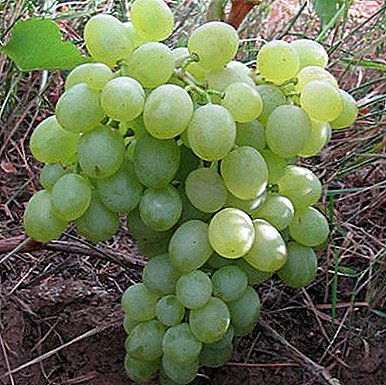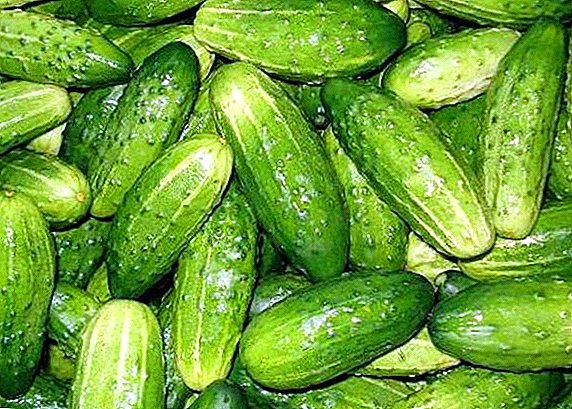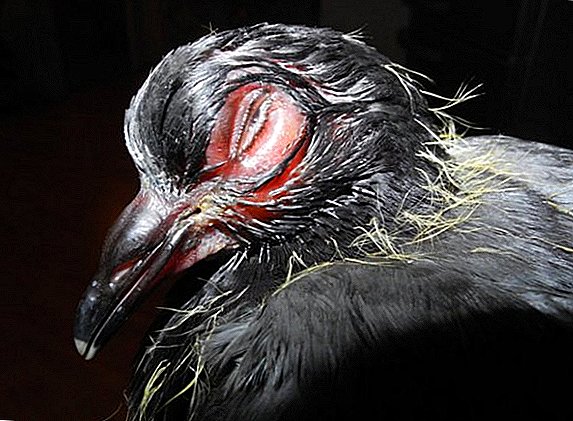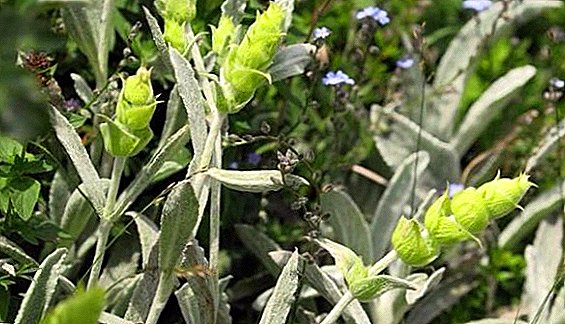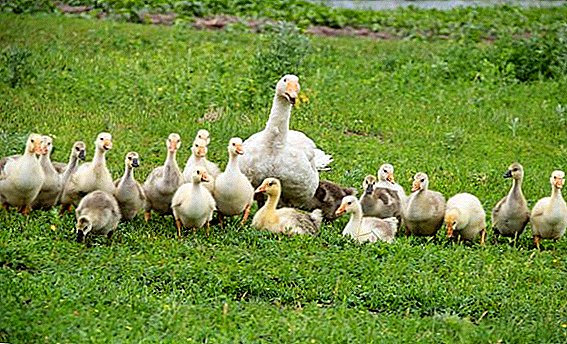 Domestic geese belong to waterfowl, which humans have long tamed in order to obtain high-quality meat, valuable, nutritious eggs and warm fluff. Cultivation of geese in the home does not require excessive effort, subject to certain rules, they will cope with them novice poultry breeder.
Domestic geese belong to waterfowl, which humans have long tamed in order to obtain high-quality meat, valuable, nutritious eggs and warm fluff. Cultivation of geese in the home does not require excessive effort, subject to certain rules, they will cope with them novice poultry breeder.
Why breed geese
Geese are bred to obtain:
- meat;
- the liver;
- eggs;
- fat;
- fluff
Did you know? Geese in the domestic bird kingdom belong to long-livers, demonstrating the ability to live to 30 years.
How to choose a young when buying
Having defined the breed of geese, you can proceed to the acquisition of goslings.  Experts do not recommend at the same time resorting to the services of poultry markets, where it is impossible to ensure guaranteed acquisition of a healthy goose of the required breed. The guarantee can be provided only in a specialized poultry farm.
Experts do not recommend at the same time resorting to the services of poultry markets, where it is impossible to ensure guaranteed acquisition of a healthy goose of the required breed. The guarantee can be provided only in a specialized poultry farm.
Familiarize yourself with the breeds of domestic geese and the basics of their breeding: Arzamas, Hungarian white, Toulouse, Rhenish, Danish legart, Tula, Chinese, Linda, large gray.
But there when you buy young stock should adhere to certain rules:
- It is best to choose the goslings of a week old because the younger chicks are less able to withstand transportation and the older birds become uncontrollable because of fearfulness.
- Yellow down body should not be dry, soft and fluffy to the touch.
- On the overgrown umbilical cord there should be no crusts, as well as on the fluff under the tail there should be no residue of secretions.
- Should alert the sagging belly goose.
- From the nostrils on the beak should not stand out.
- The most active chicks are also the most healthy, less mobile and sleepy-looking goslings can be sick.
- The health of chicks can be judged by their response to new objects or sounds, which should be fast.
- Healthy goslings can already stand firmly on their paws.
- Acquired chicks should have all vaccinations at their age.

Care of geese
If you follow all the rules of care for fast-growing geese, then a good result will not take long.
Conditions of detention
The best-selling goslings are placed in a pre-equipped. gooseberrybut may well be suitable for this and small barnwhich needs to be prepared accordingly:
- Before placing the shed into the chicks, it should be disinfected, the walls should be whitened, and a thick (at least 15 cm) layer of straw should be placed on the floor.
- With the help of additional lighting goslings need to create a 14-hour light mode.
- Very important for little goslings and temperature conditions. Warmly they need to reach two to three weeks of age.
- With a lack of heat, the chicks will huddle together and can accidentally crush someone from their fellows. And excessive heat can be fatal for little geese.
 To create an optimal temperature regime, experts recommend:
To create an optimal temperature regime, experts recommend:
- for one to five day goslings, the temperature should be maintained between 27 and 28 ° C;
- for one to two weeks - from 24 to 26 ° C;
- for two to three weeks - from 18 to 23 ° C.
Important! In no case should not keep goslings in cramped cages. Chicks need space to move.
The room where chicks are kept must be equipped with watering troughs and feeders, be clean with constantly updated straw bedding. If the weather is warm outside, then the goslings can be let out for a walk from the first days of life, but not for long, gradually accustoming them to fresh air. With stable warm weather and the presence of grown grass, goslings under supervision can be brought to pastures. A 45-day and older, you can already drive to the reservoirs.
Video: content of weekly goslings
Feeding ration
For very young goslings cook oatmeal or millet porridge, adding there chopped boiled egg or cottage cheese. After three days, finely chopped grass can be added to the feed. Monthly goslings ration is expanded due to the inclusion of grated carrots, which are given daily five times.
Very much like goslings of a mixture of such products:
- porridge;
- carrot;
- cottage cheese;
- greenery.
Important! Since geese are not able to recognize whether the food they offer is hot or, on the contrary, cold, it is necessary to carefully control the temperature of the food given to the birds.
This “dish” is served to chicks up to six times daily and should not be watery.
Grown up chicks most love fresh grass. A goose at the age of a month is able to eat about a kilogram of grass during the day.  At the same time, he has preferences in the form:
At the same time, he has preferences in the form:
- dandelion;
- sorrel;
- nettle;
- clover.
Learn more about the beneficial properties and use of dandelion, sorrel (horse, sour), nettle, clover (red).
In addition to food and drink, goslings should be provided with access to fine gravel or coarse sand, which help the bird's stomach to grind feed.
Preventive actions
Not possessing a stable immunity, goslings are often defenseless against infectious diseases. Every second goose that gets sick at a young age dies. Therefore, timely vaccination against the most dangerous diseases is extremely important for chicks. When goslings should be vaccinated and from which diseases it depends on several factors.
This takes into account:
- the prevalence of the disease in the region;
- vaccine quality;
- presence of parental immunity.
For example, to prevent salmonellosis waterfowl with unvaccinated parents, goslings are vaccinated at the age of two to four days. If the geese were vaccinated, the chicks are vaccinated at the age of eight to ten days. Vaccinations carried out at an early age, as a rule, repeat when geese mature. This is explained by the fact that early vaccination produces only short-term immunity to goslings for a particular disease, and in vaccinated adult birds it remains for a lifetime. 
Conditions of detention
Geese do not show excessive requirements for the conditions in which they are kept. However, this does not mean that they are indifferent to the environment and do not respond to taking care of themselves.
Familiarize yourself with the geese breeds: with white plumage, the largest.
Requirements for the house
Although geese mostly stay in the open air, looking for pasture on pasture, a room is still necessary for keeping them. To do this, they build a special goose, or sheds, cowsheds, and even greenhouses adapt to it. The main thing that should be taken into account is the area on which geese are located.
Each bird requires at least a square meter of "housing". Cramping in the goose boil down leads to a decrease in egg production, weight loss and deterioration in the quality of feathers and down. It is desirable that the poultry house mates with the nearby pasture and pond.  The following requirements are imposed on the gooseberry itself:
The following requirements are imposed on the gooseberry itself:
- there should be no drafts, the room should be dry, since excessive humidity is fraught with the occurrence of diseases;
- although heating is not required in the gooseberry, its walls and roof should be insulated;
- litter should be laid on the floor of a roaster at least 30 cm thick of straw, hay, shavings or sawdust, which should be clean and dry;
- for the geese in the poultry house, it is necessary to equip the nests, which are usually made of wood and provide them with a bottom to protect from the cold from below;
- artificial lighting should provide the bird with a 14-hour light day, which increases the egg production of geese;
- Although geese do not like drafts, ventilation in the goose is nevertheless necessary, so it is installed in the form of ventilation holes in the wall on one side only in order to avoid creating drafts.
Did you know? Geese, expressing their emotions, are capable of making up to a dozen sounds of different tonality. But the famous goose "ha-ha-ha" can only reproduce geese.
Pasture for walking
Being a mobile bird, geese do not tolerate long imprisonment locked up. They need a place for walking and grazing. Ideal for this purpose is a pasture with access to the reservoir. The best place for pasture is a meadow covered with low grass vegetation. It is also useful to graze geese on the land where cereals previously grew. Remains of grains give seedlings there, which are extremely useful for birds.  To determine the area of a pasture or an open-air cage for geese, one should proceed from the fact that each individual needs at least ten square meters of land to make them feel comfortable. It is useful to have some shed on the site of a walking ground to protect against excessively hot sun or rain.
To determine the area of a pasture or an open-air cage for geese, one should proceed from the fact that each individual needs at least ten square meters of land to make them feel comfortable. It is useful to have some shed on the site of a walking ground to protect against excessively hot sun or rain.
Access to water
Since geese belong to waterfowl, for their full existence water reservoir needed. And indeed, the pens with artificial pond or pastures with access to a pond or river are ideal for keeping geese. However, as a result of years of research, scientists have come to the final conclusion that the absence of a reservoir while keeping geese does not reduce their egg production or meat gain in any way.
Learn how to make your own pond for geese and ducks.
Sand trough, feeders and drinkers
Feeders for these birds should be made so that:
- the food from them was not lost;
- they provided access to feed for all birds at the same time, providing a front feeding at least 15 centimeters per bird;
- were easy to manufacture and maintain.
Many poultry farmers suspend feeders, raising them above the floor to a height of 20 centimeters, and nursery-type feeders are best for feeding geese with greens.  Geese love not only to swim in the water, but also to drink it. An adult individual, on average, consumes about a liter of water daily. From this and should proceed, arranging bird drinkers. The main requirement for goose troughs is to minimize the spillage of water on the litter, since its moisture has a detrimental effect on the health of the bird. To avoid this, drinkers are necessarily placed with large baking sheets under them to collect spilled water. Watering designs are the most diverse: ranging from primitive trough and ending with technologically advanced factory-made devices.
Geese love not only to swim in the water, but also to drink it. An adult individual, on average, consumes about a liter of water daily. From this and should proceed, arranging bird drinkers. The main requirement for goose troughs is to minimize the spillage of water on the litter, since its moisture has a detrimental effect on the health of the bird. To avoid this, drinkers are necessarily placed with large baking sheets under them to collect spilled water. Watering designs are the most diverse: ranging from primitive trough and ending with technologically advanced factory-made devices.
Consider options for self-made designs of drinking bowls for geese.
Special containers for coarse river sand, fine gravel, chalk, shells and crushed eggshell should be located in the house. This is necessary for optimal poultry digestion, during which small mineral fractions help to grind feed in a goose stomach. In addition, these mineral supplements saturate the body with essential elements.
What should take care in the winter
Before the onset of winter, the following activities should be held:
- In winter, in middle latitudes, goose traps are usually not heated, but they are carefully insulated from the side of walls and ceiling. A thick sheet of hay, straw, shavings, sawdust or sunflower husk is laid on the floor of the roaster. This litter should change frequently and never be damp.
- Since geese do not like a long stay in an enclosed space, they need to be let out outside, even in winter. Geese can briefly withstand temperatures down to minus 25-30 ° C, but the snow from the goose pen needs to be removed, replacing it with straw. Walks at frosts up to minus 10 ° C can last up to one and a half hours.
- You should also pay attention to the smell, which is peculiar to any house and does not add comfort to the existence of birds. To eliminate it, it is recommended to use superphosphate, which sprinkles the floor at the rate of 0.4 kilograms per square meter.
- Special attention in the winter period should be given to drinkers, the water in which can freeze. In order to avoid this, it is necessary either to insulate the drinkers, or to constantly replenish them with hot water.
- In order not to reduce the egg production of geese in winter, care should be taken to provide artificial lighting in the poultry house, which would provide a 14-hour light day.

Feeding ration
Feeding geese in the summer and winter periods differ radically from each other.
In the summer
As a rule, the cultivation of geese at home occurs in the warm season, so they “make up” a summer nutritious diet on their pasture themselves.
Among the herbs that they consume, preference is given to:
- all legumes;
- nettle;
- yarrow;
- plantain;
- sorrel;
- clover;
- dandelion;
- alfalfa
Read also about the healing properties and the use of yarrow, plantain, alfalfa.
If there is a reservoir near the pasture, the waterfowl will extract suitable food there. Sedges, cuffs and goose paws are among the especially unloved herbs of these birds. As geese especially like fresh greens, it is recommended to mow pasture regularly.  Average, every day these birds eat about two kilograms of grass, fully satisfying their daily need for green food. But this does not exclude evening feeding of the bird in the goose, which, in addition to replenishing the goose organism with additional calories, is also a stimulus for the active desire of the bird from the pasture home.
Average, every day these birds eat about two kilograms of grass, fully satisfying their daily need for green food. But this does not exclude evening feeding of the bird in the goose, which, in addition to replenishing the goose organism with additional calories, is also a stimulus for the active desire of the bird from the pasture home.
In the evening, waterfowers are added to the diet. coarse succulent feed in the form of:
- any grain;
- corn;
- chaff;
- beets;
- potatoes;
- carrots.
Mineral supplements must be available for poultry to help their digestion.
Tips for poultry farmers: how to determine the sex of geese, choose a goose for a tribe, slaughter and cut a goose; all about the egg laying geese.
In winter
In winter, goose food should be more protein-richthat provide any grain, for example, oats and chaff. It should be borne in mind that due to the constrained movement restriction during the winter period, the geese may gain extra weight, which negatively affects their egg production. In winter, it is necessary to feed the geese twice a day. In the morning they usually give a mash of potatoes, vegetable peelings, cereals, carrots, and beets. In the evenings, they are fed dry food from oats, barley or wheat with the addition of bone meal or fish meal.  For the daily rate of feeding geese in winter, it is customary to take a diet that includes:
For the daily rate of feeding geese in winter, it is customary to take a diet that includes:
- potatoes and beets - 500 grams;
- carrots - 100 grams;
- any kind of grain - 70 grams;
- hay meal - 150 grams;
- mineral supplements - 25 grams.
It is very useful for birds to add to the diet:
- steamed clover;
- meadow hay;
- silo;
- alfalfa;
- fruits of red rowan;
- dry brooms from maple, linden, birch, poplar.
Important! For geese it is extremely important to have water in the drinker. With its deficiency in birds, there is a deterioration in blood circulation and a disorder of the central nervous system.
There is one more specific moment peculiar to these waterfowl. Being "gallant knights", hussaks often approach the feeders only after the geese are fed. As a result, geese are often lacking in their diet. Therefore, experienced poultry farmers feed the gander separately from the geese with peas sprouted with oats, cottage cheese or cuts of meat.

Vitamin supplements
In the summer, almost all the poultry vitamins they need are extracted from green fodder, which cannot be said about the winter period. To fill this shortage, especially for vitamins A and D, add to the goose food fish fat. Also useful for waterfowl data is germinated grain, which supplies the avian organism with vitamin B2. Vitamin C deficiency is easily replaced by pine or spruce needles, which are included in the goose ration. And an almost indispensable source of almost all types of vitamins, as well as amino acids and other nutrients is silage, which must be present in the avian diet.
Learn more about silage feed: sorghum, corn.
Tips for beginners
Here are some subtleties that experienced poultry farmers recommend to beginners to pay attention to:
- Each goose should have no more than three or four geese.
- The geese start brooding, if there are at least five eggs in the nest. If there are fewer eggs, it is better to take them from the goose.
- A weight of five to six kilograms is considered ideal for slaughtering poultry for meat. All extra pounds are solely for fat.
- Quite often, geese start laying eggs only in the second year of life.
- Lack of walking for geese is bad on all sides, and first of all, in the material sense, since in summer you have to spend much more on food.
- Herd of geese annually must be diluted with young animals in the amount of 20-30 percent of the number of existing heads.
Video: content geese
Growing these beautiful birds at home, while observing simple rules for caring for geese, often turns from a purely profitable enterprise into a kind of rest from the intrusive benefits of civilization, the familiarization of man with the mysteries of nature.




